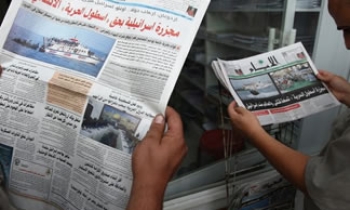Job cuts, benefit reductions, and reduced newspaper sizes are part of a plan to improve margins by as much as $150 million a year at newspaper chain Knight Ridder Inc., according to people familiar with presentations management has been making to potential buyers.
The country's second-largest newspaper chain put itself on the block late last year, under pressure from its biggest shareholders. Now the company's top executives -- including namesake heir Tony Ridder -- are laying out their vision of the company's financial future to a group of private-equity and newspaper-industry suitors.
The vision, according to people familiar with the plan, involves increasing annual earnings before interest, taxes, depreciation and amortization to about $825 million over the next 18 months. That represents an improvement of about 20% from 2004, when the company reported Ebitda of $685.9 million.
To reach that level, the company sees a buyer relying on "streamlined" operations as well as a plan to reduce the physical sizes of some of Knight Ridder's 32 daily newspapers.
Reducing costs is key to a company whose revenue has barely been keeping pace with the overall rate of inflation. And it will be essential to private-equity buyers, who will need to extract more cash to help reduce new debt used to purchase the company.
But the buyers have viewed Knight Ridder's projections as overly optimistic, according to two people familiar with the matter. And they are treading cautiously as they do their own analysis -- which is pushing back the resolution of the auction to late February or early March, these people said yesterday.
Lenders have proved eager to play in the auction. They are offering to fund debt totaling as much as 8.5 times Knight Ridder's Ebitda over the past 12 months, or about $5.4 billion, according to people familiar with the matter. Buyers aren't likely to take on that much debt, but those numbers show that they have plenty in reserve should a bidding war heat up.
Knight Ridder, San Jose, Calif., has a $4.3 billion market capitalization and sales of just above $3 billion over the past 12 months.
One question sure to be hanging over the process is how these financial changes may affect the quality of journalism at the publisher of such venerable titles as the Philadelphia Inquirer, the Charlotte Observer and the Fort Worth Star-Telegram. Some of the company's 18,000 employees, 28% of whom are represented by unions, have discussed their own buyout plan.
"If you're going to buy the whole company, you probably have to go into it with a plan to tighten it up and get a better margin out of it," said John Cribb, principal broker at Cribb & Associates LLC, a leading newspaper brokerage firm based in Bozeman, Mont. Mr. Cribb said there is room to do this at Knight Ridder without damaging the product. "They're certainly not the tightest operators out there," he said.
A spokesman for the Communications Workers of America, which represents Knight Ridder employees, couldn't be reached for comment.
Knight Ridder's largest paper, the Philadelphia Inquirer, has already been through a number of cuts and shouldn't be required to sustain any more, says Henry J. Holcomb, president of the Newspaper Guild of Greater Philadelphia, which represents about 1,000 employees at the Inquirer and the Philadelphia Daily News.
"The paper is down to a number that is smaller than when I arrived," says Mr. Holcomb, a business writer who joined the Inquirer in 1983. "There has been no in-house study that says we can do more with any less. This is just manipulating numbers."
Knight Ridder spokesman Polk Laffoon said he couldn't comment.
Write to Dennis K. Berman at dennis.berman@wsj.com and Joseph T. Hallinan at joe.hallinan@wsj.com









